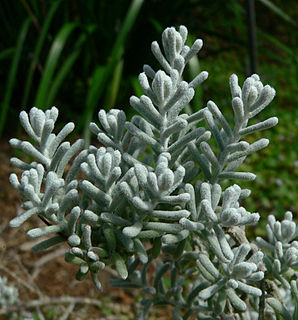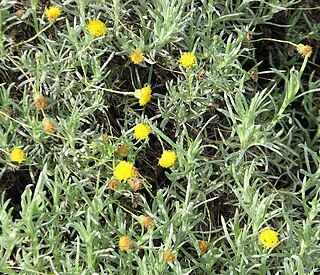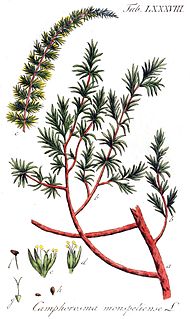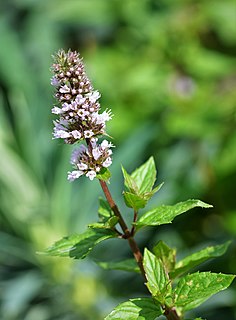
Correa is a genus of eleven species of flowering plants in the family Rutaceae that are endemic to Australia. Plants in the genus Correa are shrubs to small trees with simple leaves arranged in opposite pairs, bisexual flowers with four sepals, four petals usually fused for most of their length and eight stamens.

Myrtaceae or the myrtle family is a family of dicotyledonous plants placed within the order Myrtales. Myrtle, pohutukawa, bay rum tree, clove, guava, acca (feijoa), allspice, and eucalyptus are some notable members of this group. All species are woody, contain essential oils, and have flower parts in multiples of four or five. The leaves are evergreen, alternate to mostly opposite, simple, and usually entire. The flowers have a base number of five petals, though in several genera the petals are minute or absent. The stamens are usually very conspicuous, brightly coloured and numerous.

The Cyperaceae are a family of graminoid (grass-like), monocotyledonous flowering plants known as sedges. The family is large, with some 5,500 known species described in about 90 genera, the largest being the "true sedges" genus Carex with over 2,000 species.

Maireana sedifolia, also known as the bluebush or pearl bluebrush is a compact shrub endemic to Australia, and found in New South Wales, Victoria, South Australia, Western Australia, and the Northern Territory. It is used in pasture and as a garden plant where it is popular due to its distinctive grey foliage.

Philotheca is a genus of about fifty species of flowering plants in the family Rutaceae. Plants in this genus are shrubs with simple leaves arranged alternately along the stems, flowers that usually have five sepals, five petals and ten stamens that curve inwards over the ovary. All species are endemic to Australia and there are species in every state, but not the Northern Territory.

Chrysocephalum, known by the common name everlastings for their long life as cut flowers, is a genus of flowering plants in the family Asteraceae. There are six species, all of which were formerly classified under other genera.

Phebalium is a genus of thirty species of shrubs or small trees in the family Rutaceae and is endemic to Australia. The leaves are arranged alternately, simple and often warty, the flowers arranged singly or in umbels on the ends of branchlets or in leaf axils, usually with five sepals, five petals and ten stamens. There are about thirty species and they are found in all Australian states but not in the Northern Territory.

Maireana is a genus of around 57 species of perennial shrubs and herbs in the family Amaranthaceae which are endemic to Australia. Species in this genus were formerly classified within the genus Kochia. The genus was described in 1840 by the botanist, Moquin-Tandon and named to honour Joseph François Maire (1780-1867), an amateur botanist who befriended him during the author's first visit to Paris in 1834.

Leionema is a genus of more than 20 species of mostly small shrubs in the family Rutaceae, most of which are endemic to eastern Australia. Plants within this genus have scented foliage and clustered, star-shaped flowers which range in colour from cream to bright yellow. Prior to 1998, all species within this genus were included in the genus Phebalium.
Hyalosperma is a genus of Australian flowering plants in the sunflower family.

Leiocarpa is a genus of plants in the family Asteraceae, native to Australia.

Chrysocephalum semipapposum is a perennial herb in the family Asteraceae. It produces yellow terminal flower heads in clusters, mainly between spring and early summer.

Coronidium is a genus of flowering plants in the sunflower family. The genus is endemic to Australia.

Camphorosmeae is a species-rich tribe of the Amaranthaceae, formerly Chenopodiaceae, with 20 genera and about 179 species. It is classified as a single tribe of subfamily Camphorosmoideae.
Haegiela is a genus of flowering plants in the daisy family described as a genus in 1990. There is only one known species, Haegiela tatei, native to South Australia, and Victoria.

Nepetoideae is a subfamily of plants in the family Lamiaceae.

Chenopodium desertorum, common name frosted goosefruit, is a species of flowering plant in the family Amaranthaceae, indigenous to Australia where it is found in all mainland states.

Roycea is a genus of plants formerly in the family Chenopodiaceae, and now in the Amaranthaceae. The genus was first described in 1948 by Charles Austin Gardner, and the genus name honours Robert Dunlop Royce. The entire genus is endemic to Western Australia. There are no synonyms.
Paul Graham Wilson is an Australian botanist. He has been the most prolific contributor to the journal Nuytsia, contributing to the first issue in 1970 and to the 12th volume in 1998, which was dedicated to him for his contributions to plant taxonomy and to celebrate his 70th birthday. Since his retirement from the Western Australian Herbarium in 1993, he has helped to maintain a comprehensive census of the flora of Western Australia.
Dissocarpus is a genus of flowering plants belonging to the family Amaranthaceae.















